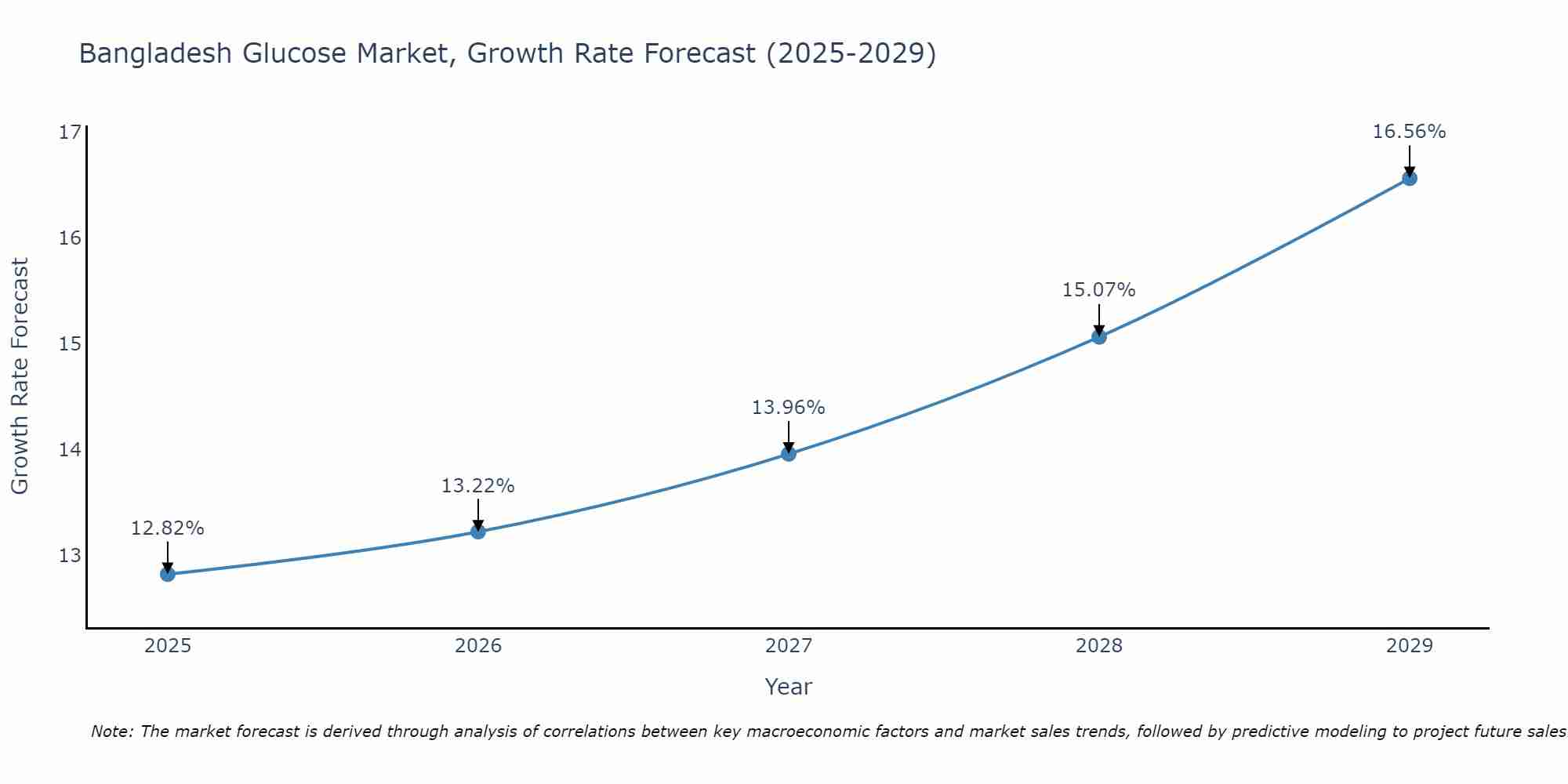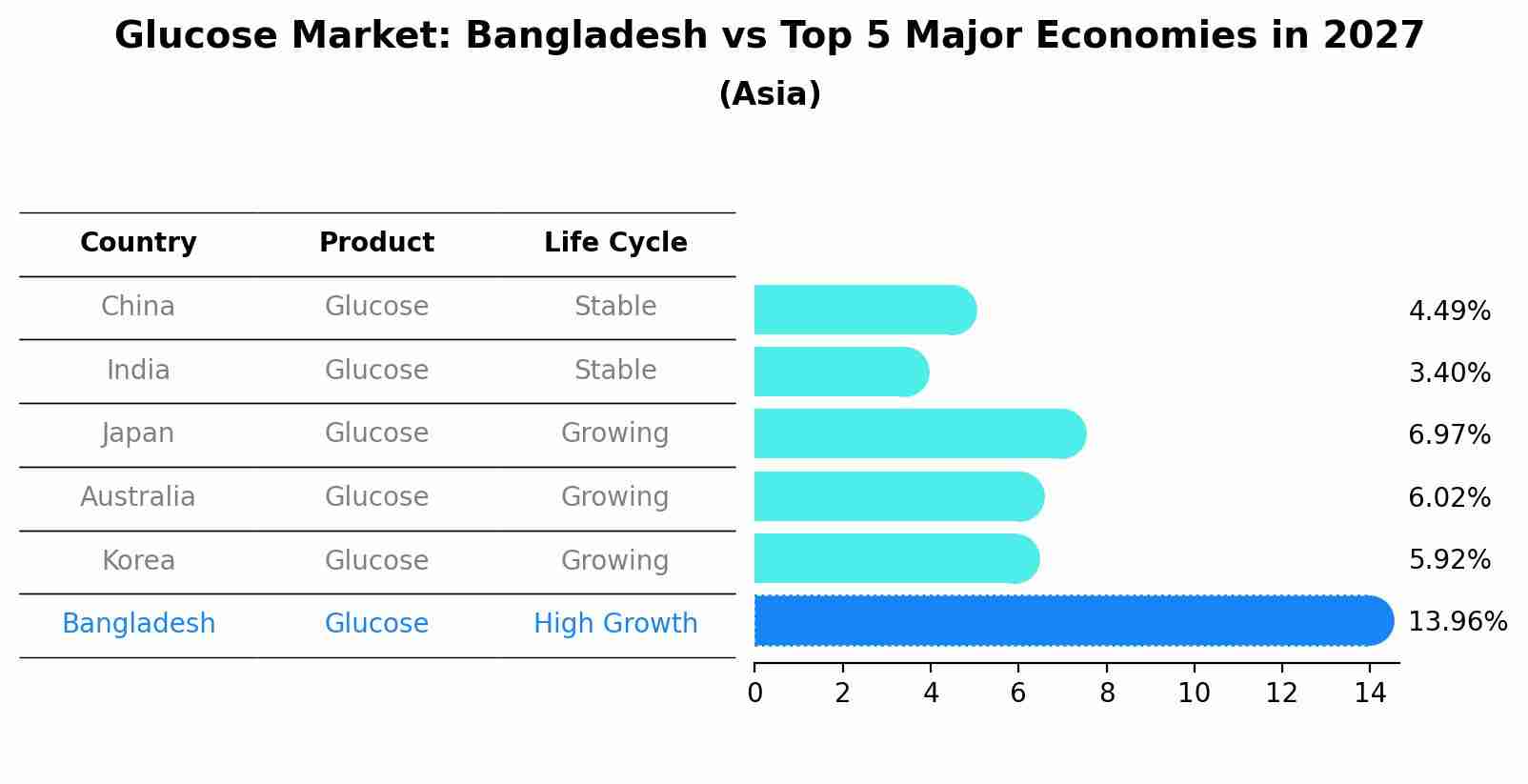Bangladesh Glucose Market (2025-2031) Outlook | Companies, Industry, Analysis, Forecast, Value, Revenue, Size, Trends, Growth, Share
| Product Code: ETC126036 | Publication Date: Jun 2021 | Updated Date: Jun 2025 | Product Type: Report | |
| Publisher: 6Wresearch | Author: Shubham Deep | No. of Pages: 70 | No. of Figures: 35 | No. of Tables: 5 |
Bangladesh Glucose Market Size Growth Rate
The Bangladesh Glucose Market is likely to experience consistent growth rate gains over the period 2025 to 2029. The growth rate starts at 12.82% in 2025 and reaches 16.56% by 2029.

Glucose Market: Bangladesh vs Top 5 Major Economies in 2027 (Asia)
By 2027, the Glucose market in Bangladesh is anticipated to reach a growth rate of 13.96%, as part of an increasingly competitive Asia region, where China remains at the forefront, supported by India, Japan, Australia and South Korea, driving innovations and market adoption across sectors.

Bangladesh Glucose Market Overview
The Bangladesh glucose market is experiencing steady growth driven by factors such as increasing consumer awareness about health and wellness, rising disposable income, and the growing popularity of convenience foods. Glucose products are widely utilized as a source of instant energy and are particularly popular among athletes, students, and individuals seeking quick energy boosts. The market is characterized by a wide range of glucose products including liquid glucose, glucose powder, and glucose tablets, with key players focusing on product innovation, marketing strategies, and distribution networks to gain a competitive edge. The market is also witnessing a trend towards natural and healthier alternatives to traditional glucose products, presenting opportunities for manufacturers to cater to the evolving consumer preferences in the country.
Bangladesh Glucose Market Trends
The Bangladesh Glucose Market is experiencing a growing demand for healthier and more functional glucose products. Consumers are increasingly seeking glucose products that offer added health benefits, such as low sugar content, natural ingredients, and energy-boosting properties. There is a rising trend towards glucose products fortified with vitamins, minerals, and electrolytes to cater to the health-conscious consumer segment. Additionally, there is a growing preference for convenient and on-the-go glucose products like energy bars and drinks. Manufacturers in the Bangladesh Glucose Market are focusing on innovation and product diversification to meet the evolving consumer preferences and capitalize on the increasing demand for healthier glucose options. Overall, the market is witnessing a shift towards healthier and more functional glucose products to align with consumer demands for better nutrition and wellness.
Bangladesh Glucose Market Challenges
The Bangladesh Glucose Market faces several challenges, including intense competition from local and international brands, fluctuating raw material prices, and changing consumer preferences. The market is also impacted by issues such as counterfeit products, inadequate distribution networks in rural areas, and the lack of stringent regulations. Additionally, economic uncertainties, political instability, and the impact of global events can further disrupt the market. Market players must navigate these challenges by focusing on product innovation, quality control, effective marketing strategies, and building strong relationships with distributors to ensure sustained growth and competitiveness in the Bangladesh Glucose Market.
Bangladesh Glucose Market Investment Opportunities
The Bangladesh Glucose Market presents promising investment opportunities due to the increasing consumer awareness about health and wellness, driving demand for low-calorie sweeteners such as glucose. With a growing population and rising disposable income levels, the market is expected to witness substantial growth in the coming years. Investing in glucose production facilities, distribution networks, and innovative product development can be lucrative strategies. Additionally, partnerships with local manufacturers or distributors can help navigate the competitive landscape and establish a strong presence in the market. Overall, the Bangladesh Glucose Market offers potential for investors seeking to capitalize on the evolving consumer preferences towards healthier sweetening options.
Bangladesh Glucose Market Government Policy
The Bangladesh government has implemented policies to regulate the glucose market, including setting quality standards to ensure product safety and consumer protection. The government has also introduced pricing regulations to prevent price manipulation and ensure affordability for consumers. Additionally, there are policies in place to monitor and control the production and distribution of glucose products to maintain market stability and prevent monopolies. These regulations aim to promote fair competition, protect consumer rights, and maintain a healthy market environment for glucose products in Bangladesh.
Bangladesh Glucose Market Future Outlook
The Bangladesh glucose market is anticipated to experience steady growth in the upcoming years due to several factors, including increasing urbanization, changing dietary habits, and rising awareness about health and wellness. The demand for glucose products is expected to rise as consumers seek convenient and quick energy sources. Additionally, the growing popularity of sports and fitness activities is likely to drive the demand for glucose-based products among athletes and fitness enthusiasts. Manufacturers are expected to focus on product innovation and marketing strategies to cater to the evolving consumer preferences. However, challenges such as price fluctuations of raw materials and intense competition in the market may impact the market growth to some extent. Overall, the Bangladesh glucose market is poised for expansion in the foreseeable future.
Key Highlights of the Report:
- Bangladesh Glucose Market Outlook
- Market Size of Bangladesh Glucose Market, 2021
- Forecast of Bangladesh Glucose Market, 2031
- Historical Data and Forecast of Bangladesh Glucose Revenues & Volume for the Period 2021 - 2031
- Bangladesh Glucose Market Trend Evolution
- Bangladesh Glucose Market Drivers and Challenges
- Bangladesh Glucose Price Trends
- Bangladesh Glucose Porter's Five Forces
- Bangladesh Glucose Industry Life Cycle
- Historical Data and Forecast of Bangladesh Glucose Market Revenues & Volume By Source for the Period 2021 - 2031
- Historical Data and Forecast of Bangladesh Glucose Market Revenues & Volume By Wheat for the Period 2021 - 2031
- Historical Data and Forecast of Bangladesh Glucose Market Revenues & Volume By Corn for the Period 2021 - 2031
- Historical Data and Forecast of Bangladesh Glucose Market Revenues & Volume By Others for the Period 2021 - 2031
- Historical Data and Forecast of Bangladesh Glucose Market Revenues & Volume By Type for the Period 2021 - 2031
- Historical Data and Forecast of Bangladesh Glucose Market Revenues & Volume By Food and Beverage for the Period 2021 - 2031
- Historical Data and Forecast of Bangladesh Glucose Market Revenues & Volume By Pharmaceuticals for the Period 2021 - 2031
- Historical Data and Forecast of Bangladesh Glucose Market Revenues & Volume By Others for the Period 2021 - 2031
- Bangladesh Glucose Import Export Trade Statistics
- Market Opportunity Assessment By Source
- Market Opportunity Assessment By Type
- Bangladesh Glucose Top Companies Market Share
- Bangladesh Glucose Competitive Benchmarking By Technical and Operational Parameters
- Bangladesh Glucose Company Profiles
- Bangladesh Glucose Key Strategic Recommendations
Frequently Asked Questions About the Market Study (FAQs):
Bangladesh Glucose |
1 Executive Summary |
2 Introduction |
2.1 Key Highlights of the Report |
2.2 Report Description |
2.3 Market Scope & Segmentation |
2.4 Research Methodology |
2.5 Assumptions |
3 Bangladesh Glucose Market Overview |
3.1 Bangladesh Country Macro Economic Indicators |
3.2 Bangladesh Glucose Market Revenues & Volume, 2021 & 2031F |
3.3 Bangladesh Glucose Market - Industry Life Cycle |
3.4 Bangladesh Glucose Market - Porter's Five Forces |
3.5 Bangladesh Glucose Market Revenues & Volume Share, By Source, 2021 & 2031F |
3.6 Bangladesh Glucose Market Revenues & Volume Share, By Type, 2021 & 2031F |
4 Bangladesh Glucose Market Dynamics |
4.1 Impact Analysis |
4.2 Market Drivers |
4.3 Market Restraints |
5 Bangladesh Glucose Market Trends |
6 Bangladesh Glucose Market, By Types |
6.1 Bangladesh Glucose Market, By Source |
6.1.1 Overview and Analysis |
6.1.2 Bangladesh Glucose Market Revenues & Volume, By Source, 2018 - 2027F |
6.1.3 Bangladesh Glucose Market Revenues & Volume, By Wheat, 2018 - 2027F |
6.1.4 Bangladesh Glucose Market Revenues & Volume, By Corn, 2018 - 2027F |
6.1.5 Bangladesh Glucose Market Revenues & Volume, By Others, 2018 - 2027F |
6.2 Bangladesh Glucose Market, By Type |
6.2.1 Overview and Analysis |
6.2.2 Bangladesh Glucose Market Revenues & Volume, By Food and Beverage, 2018 - 2027F |
6.2.3 Bangladesh Glucose Market Revenues & Volume, By Pharmaceuticals, 2018 - 2027F |
6.2.4 Bangladesh Glucose Market Revenues & Volume, By Others, 2018 - 2027F |
7 Bangladesh Glucose Market Import-Export Trade Statistics |
7.1 Bangladesh Glucose Market Export to Major Countries |
7.2 Bangladesh Glucose Market Imports from Major Countries |
8 Bangladesh Glucose Market Key Performance Indicators |
9 Bangladesh Glucose Market - Opportunity Assessment |
9.1 Bangladesh Glucose Market Opportunity Assessment, By Source, 2021 & 2031F |
9.2 Bangladesh Glucose Market Opportunity Assessment, By Type, 2021 & 2031F |
10 Bangladesh Glucose Market - Competitive Landscape |
10.1 Bangladesh Glucose Market Revenue Share, By Companies, 2021 |
10.2 Bangladesh Glucose Market Competitive Benchmarking, By Operating and Technical Parameters |
11 Company Profiles |
12 Recommendations |
13 Disclaimer |
- Single User License$ 1,995
- Department License$ 2,400
- Site License$ 3,120
- Global License$ 3,795
Search
Related Reports
- Portugal Electronic Document Management Market (2025-2031) | Strategy, Consumer Insights, Analysis, Investment Trends, Opportunities, Growth, Size, Share, Industry, Revenue, Segments, Value, Segmentation, Supply, Forecast, Restraints, Outlook, Competition, Drivers, Trends, Demand, Pricing Analysis, Competitive, Strategic Insights, Companies, Challenges
- France Electronic Document Management Market (2025-2031) | Strategy, Consumer Insights, Analysis, Investment Trends, Opportunities, Growth, Size, Share, Industry, Revenue, Segments, Value, Segmentation, Supply, Forecast, Restraints, Outlook, Competition, Drivers, Trends, Demand, Pricing Analysis, Competitive, Strategic Insights, Companies, Challenges
- Portugal Occupational Health & Safety Services Market (2025-2031) | Strategy, Consumer Insights, Analysis, Investment Trends, Opportunities, Growth, Size, Share, Industry, Revenue, Segments, Value, Segmentation, Supply, Forecast, Restraints, Outlook, Competition, Drivers, Trends, Demand, Pricing Analysis, Competitive, Strategic Insights, Companies, Challenges
- Netherlands Occupational Health and Safety Services Market (2025-2031) | Strategy, Consumer Insights, Analysis, Investment Trends, Opportunities, Growth, Size, Share, Industry, Revenue, Segments, Value, Segmentation, Supply, Forecast, Restraints, Outlook, Competition, Drivers, Trends, Demand, Pricing Analysis, Competitive, Strategic Insights, Companies, Challenges
- Belgium and Luxembourg Facility Management Market (2025-2031) | Strategy, Consumer Insights, Analysis, Investment Trends, Opportunities, Growth, Size, Share, Industry, Revenue, Segments, Value, Segmentation, Supply, Forecast, Restraints, Outlook, Competition, Drivers, Trends, Demand, Pricing Analysis, Competitive, Strategic Insights, Companies, Challenges
- Russia Women Intimate Apparel Market (2025-2031) | Strategy, Consumer Insights, Analysis, Investment Trends, Opportunities, Growth, Size, Share, Industry, Revenue, Segments, Value, Segmentation, Supply, Forecast, Restraints, Outlook, Competition, Drivers, Trends, Demand, Pricing Analysis, Competitive, Strategic Insights, Companies, Challenges
- Africa Chocolate Market (2025-2031) | Size, Share, Trends, Growth, Revenue, Analysis, Forecast, industry & Outlook
- Global Hydroxychloroquine And Chloroquine Market (2025-2031) | Industry, Trends, Size, Outlook, Growth, Value, Companies, Revenue, Analysis, Share, Forecast
- Saudi Arabia Plant Maintenance Market (2025-2031) | Industry, Size, Growth, Revenue, Value, Companies, Forecast, Analysis, Share & Trends
- Taiwan Electric Truck Market (2025-2031) | Outlook, Industry, Revenue, Size, Forecast, Growth, Analysis, Share, Companies, Value & Trends
Industry Events and Analyst Meet
Our Clients
Whitepaper
- Middle East & Africa Commercial Security Market Click here to view more.
- Middle East & Africa Fire Safety Systems & Equipment Market Click here to view more.
- GCC Drone Market Click here to view more.
- Middle East Lighting Fixture Market Click here to view more.
- GCC Physical & Perimeter Security Market Click here to view more.
6WResearch In News
- Doha a strategic location for EV manufacturing hub: IPA Qatar
- Demand for luxury TVs surging in the GCC, says Samsung
- Empowering Growth: The Thriving Journey of Bangladesh’s Cable Industry
- Demand for luxury TVs surging in the GCC, says Samsung
- Video call with a traditional healer? Once unthinkable, it’s now common in South Africa
- Intelligent Buildings To Smooth GCC’s Path To Net Zero













